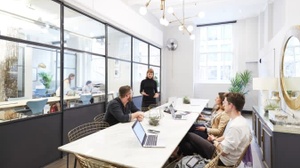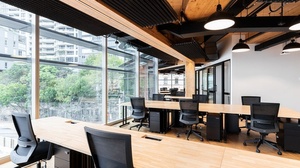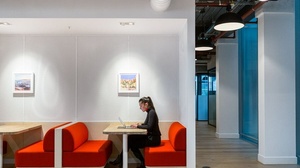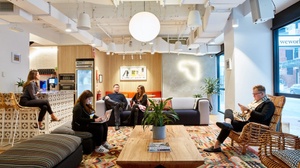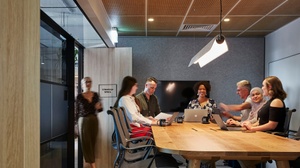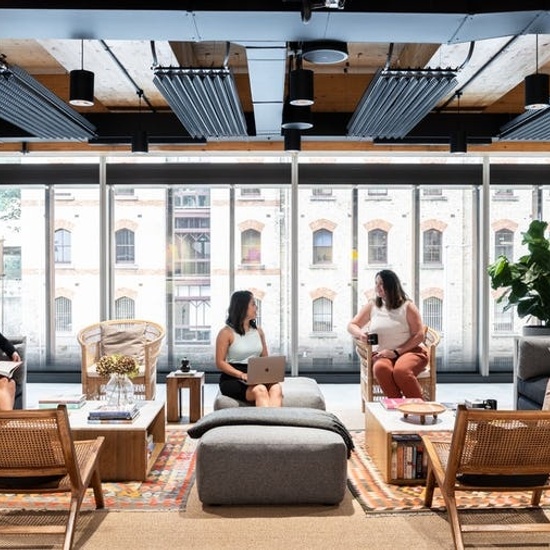
Australia's Coworking Guide
Everything you need to know about Coworking, Flexible Office Space, and Serviced Offices
Nearly a decade ago, researchers studied how and why people thrive at work. The data showed that employees who belong to a coworking space report levels of thriving at an average of 6 on a scale of 1 to 7, which is an entire point higher than for those who work in a traditional office.
Perhaps that's why a whopping 3.1 million people are currently utilizing coworking spaces around the globe — a figure that's projected to grow by 5 million in the next several years.
The numbers don't lie: Coworking is booming, and for good reason. Those who jump on the bandwagon continuously reap its many benefits in both their personal and professional lives.
In this detailed guide, you'll discover everything you need to know about the innovative and flourishing world of coworking — from insider lingo to top operators and pandemic protocols. Whether you're an independent contractor or the CEO of a big company, you’ll learn how you can leverage coworking to increase productivity, create community, and expand your network.
- What is Coworking
- The History of Coworking in Australia
- Common Terminology
- Who uses Coworking
- Types of Membership Available
- Benefits of Coworking
- Coworking vs Working from Home
- Coworking vs Serviced Offices
- What Type of Spaces are Available?
- What Does a Coworking Space Cost?
- What to Look for when Searching for a Coworking Space
- Australia's Top Coworking Operators
- Find the Right Fit
What Is Coworking?

Before delving into the nitty-gritty details of coworking, let’s lay out what it actually is. If you punch this term into Google, you'll find the following definition:
The use of an office or other working environment by people who are self-employed or working for different employers, typically so as to share equipment, ideas, and knowledge.
That pretty much sums it up. To be more specific, though, coworking is when someone signs a contract to license their use of an office space that’s owned or leased by someone else.
Although coworking hasn't been on the scene for very long, it has an explosive history. In a relatively short time, coworking has gone from a small-scale business venture to a phenomenon that encompasses the entire globe, single-handedly defining what the future of work will be.
READY TO MOVE?
Rubberdesk is your one-stop shop to Research and Find your next office.
Or Call 1300 433 757
The History of Coworking in Australia
Coworking companies have operated in Australia since the mid-1980s, but the term itself wasn't coined until 1999 when game designer Bernard DeKoven wanted a word for ways of working that involves collaboration, a breakdown of hierarchical structures, and seeing employees as equals.
The world's first official coworking space wasn't set up until 2005. Founder Brad Neuberg's intention for the San Francisco Coworking Space was to maintain the freedom of independent working while offering the structure and community that come with working alongside others.
This understanding slowly made its way to Australia's business districts. In 2013, there were only 78 coworking locations in Australia's two main cities. Within a mere six years, that number grew to a staggering 400, and far more have been added since that 2019 statistic was tallied.
The catalysts for the main changes that took place since the genesis of flexible office spaces in Australia were an increased demand from younger staff to work away from the office and the boom of startups and small businesses. This led to improved technology, the introduction of hot-desking, and more.
The majority of new office buildings have at least one flexible floor to be leased out.
And the trend isn't going away soon. In fact, it's projected to become the new norm. According to one report, coworking office spaces in Australia are expected to triple by 2030. By then, nearly 12% of the nation's all-commercial office stock is expected to be used for coworking, and the industry is projected to increase Australia's economic output by a whopping $122 billion.
Common Terminology
If you're considering joining a coworking space, you'll do well to become fluent in coworking-speak. Here’s a selection of common terms and what they mean:
Hot Desk
Hot-desking refers to a workspace system in which desks are rotated among people on an ad hoc basis. Hot desks can be implemented in coworking setups as well as private offices.
Because hot desks don’t provide any sense of permanence, there’s less and less demand for this one-time trend. As a result, most coworking operators have significantly cut down on the number of hot desks available to rent.
Dedicated Desk
A dedicated desk is a membership option that provides a workspace just for you. It provides a more permanent setup and more privacy compared to hot-desking or using shared spaces only. You can also curate the space and leave your supplies right where you left them.
Managed Office
A managed office is a vacant space that’s rented out by a landlord or property owner. It doesn’t typically come with furnishings, business opportunities, reception services, or other amenities.
Flexible Space
A flexible, or "flex" space refers to any space that’s offered to businesses that can tailor it according to their needs.
Tell us how we can help you
We'll narrow down the best options that meet your unique requirements.
Or Call 1300 433 757
Who Uses Coworking?
When coworking began, it was largely geared toward entrepreneurs, freelancers, and startups. In many ways, the industry still caters to these kinds of businesses, but it has also expanded to incorporate companies of all sizes.
Coworking is utilised by all of the following:
- Entrepreneurs
- Lawyers
- Financial professionals
- Agencies
- Small businesses
- Startups
- Construction companies
- Large corporations, including Amazon, Microsoft, and Google
Types of Memberships Available
There are a variety of membership models available for coworking spaces. Members typically pay a weekly or monthly subscription fee that’s determined by several factors, including:
Frequency
With coworking, you pay only for what you need, so most membership models are based on how often you need to use the space.
You might pay for full-time access, a specific number of days or hours per week, or occasional hourly access. The latter works well for people who are in town only for a short time or are working on a project outside of their regular hours. This is sometimes referred to as a weekend plan. Some spaces even offer discounted rates for workers who require only nighttime access.
It all depends on the needs of the member.
Dedicated Space
There are numerous options for dedicated spaces, including:
- Full-floor offices
- Office suites
- Standard offices
- Shared spaces
- Dedicated desks
- Hot desks
- Virtual workspaces
Number of People
For employers who wish to purchase a plan for a team, the number of people is usually factored into the price in addition to the dedicated space.
Additional Services and Access
There are always extras for members to incorporate into their membership plan, such as:
- After-hours access
- Specific technology
- A mailing address
- Printing
- Phone services
Acceptance
Lastly, some coworking operators are more exclusive with their approach to membership. For example, they may want to stick to specific industries or require you to pass an interview process before you can become a member. Because community is so vital to coworking, operators care about the kind of community they create or curate.
Benefits of Coworking
 There's a reason coworking is quickly becoming the new way to work: It provides a wide range of benefits — ones that aren't usually provided by the traditional office setup. Here are some of the main draws:
There's a reason coworking is quickly becoming the new way to work: It provides a wide range of benefits — ones that aren't usually provided by the traditional office setup. Here are some of the main draws:
Inspiration and Collaboration
One of the main benefits of coworking spaces is that they provide an opportunity for independent workers to draw upon each other's skill sets. Instead of being pigeonholed by your distinct company or position, you can meet and collaborate with people outside of your industry. And with many spaces offering networking events, you have a built-in way to broaden your connections. In this environment, the best ideas take flight.
Flexibility
Coworking spaces are flexible in more ways than one. You're able to choose from a variety of membership options, locations, and workspaces. Many spaces are even open around the clock. The leasing terms are flexible, too — you can scale up or down whenever you need to.
Productivity
There are heaps of statistics out there about how coworking increases productivity. In a recent study, 84% of the 700 coworkers surveyed reported feeling more engaged and motivated when they were in a coworking space, and 89% reported being happier.
Low Costs
Compared to the exorbitant costs of renting out an office building, coworking is a very cheap option. Moreover, occasionally renting out a coworking space is considered a tax-deductible expense as long as it's solely for the purpose of your business.
Amenities
At coworking spaces, the amenities are extensive. The perks offered in the vast majority of spaces include:
- Coffee and tea
- Wi-Fi and ethernet connection
- Networking and other events
- Printing
- Parking
- Kitchen
- Meeting and conference rooms
- Hot-desking and dedicated desks
Some spaces offer additional specialized amenities such as:
- Virtual services
- Snacks
- Beer
- A concierge service
- On-site massages
- Bike racks
- Yoga classes
- Wellness stations
- Outdoor spaces
- Pet-friendly settings
- Child care
- Showers
Coworking vs. Working From Home
 Coworking or working from home (WFH): Which is better? It's a fair question, especially in a post-pandemic age.
Coworking or working from home (WFH): Which is better? It's a fair question, especially in a post-pandemic age.
Obviously, a WFH setup is entirely free. It also provides a certain level of convenience — cutting out commuting time, for example. The benefits are pretty scarce beyond that, however, and there are significant downsides.
For one, it makes achieving a work-life balance nearly impossible. Many freelancers and WFH professionals also experience high levels of boredom and loneliness, which can quickly begin negatively impacting your mental health and overall well-being. It also makes your motivation plummet.
Coworking makes up for where working from home fails. As we mentioned above, productivity is one of the chief benefits of coworking arrangements. Being around people and in a professional environment increases your levels of productivity and happiness.
Some people opt to enhance WFH by adding in occasional coworking, whether it's for a few hours or days each week. This is a great option for those who are still on the fence.
Coworking vs. Serviced Offices
The differences between serviced offices and coworking can be hard to catch, especially because many people use the two terms interchangeably. The two concepts diverge in three key ways:
Workspace
Coworking spaces usually have a more open floor plan, which is built for community and collaboration. They offer flexible leases and a variety of workspace options as well as amenities.
Serviced offices are usually more broken up. They may have cubicles or private offices and suites. Some offer hot desks and dedicated desks along with coworking spaces, however.
Design
The environment of coworking spaces is typically more casual. Many facilities are modern, aesthetically pleasing, and unique.
In serviced offices, the vibe is more corporate, catering to a professional and private working environment.
Culture
Lastly, the culture of coworking spaces is imbued with an entrepreneurial and communal spirit. The staff works to create new opportunities for collaboration and connection between members.
Serviced offices rarely have a distinct culture, as businesses are in and out.
What Types of Spaces Are Available?
Today, there are extensive options when it comes to coworking spaces, including:
- Full-service
- Private
- Shared
- Lifestyle
- Subleased
- Specialized
- Virtual
- Floor
- Office suite
- Event
- Meeting/conference room
Explore the 10 most common flexible office space types today.
What Does a Coworking Space Cost?
The cost of a single coworking desk or hot desk varies across Australia. You'll pay more in Sydney and Melbourne compared to Perth and Brisbane.
- Sydney: $621
- North Sydney: : $550
- Melbourne: $500
- Brisbane: $500
- Perth: $495
- Adelaide: $550
- Canberra: $330
We've put together a detailed summary of costs across most major markets including:
- Sydney's Office Price Guide
- Melbourne's Office Price Guide
- Brisbane's Office Price Guide
- Perth's Office Price Guide
- Adelaide's Office Price Guide
- Canberra's Office Price Guide
Check out these other top locations for coworking desks near you:
- Docklands Coworking
- Southbank Coworking
- St Kilda Coworking
- Fortitude Valley Coworking
- North Sydney Coworking
- Manly Coworking
- Paramatta Coworking
What To Look for When Searching for a Coworking Space for Your Business
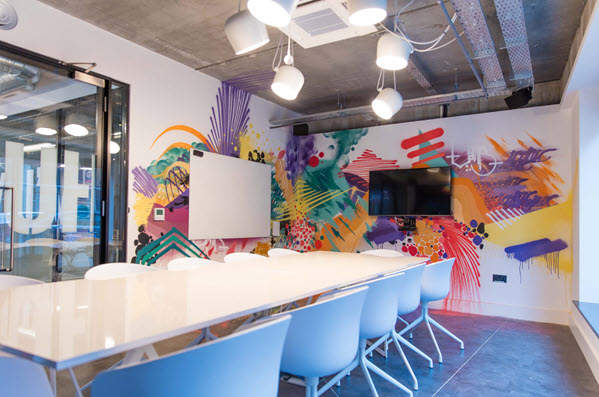 There are various factors to consider when choosing the right coworking space for you.
There are various factors to consider when choosing the right coworking space for you.
The most important component is the location — you'll not only want to find a space that's easy to commute to, but one that's also near shops, restaurants, and other businesses.
Next, you'll want to think about what kind of workspace is best suited to your needs, and what kinds of resources you want access to. And don't forget amenities. Ask yourself: What perks do I want with my membership?
Last but not least, you must consider the cost. As mentioned earlier, there’s a range of membership plans available, each at a different cost.
Once you've narrowed down your list of coworking spaces, go ahead and schedule a time to tour the space. Get a feel for the environment (taking note of things like natural light and noise levels), sense of community, and quality of the materials.
These factors should play into your decision:
- Location
- Layout
- Access to meeting rooms
- Community and collaboration
- Sign-up/renewal process
- Pricing
- Flexibility
- Work environment
- Comfort
- Events and education
- Cleaning protocols
Top Coworking Operators in Australia
When it comes to choosing a coworking space or serviced office, your options are vast. There's the international operators such as WeWork and Servcorp as well as 5-star local operators such as Hub Australia, Christie Spaces and more.
Compare Coworking Operators
- WeWork vs Regus
- WeWork vs Servcorp
- WeWork vs Spaces
- Servcorp vs Spaces
- WeWork vs Hub Australia
- Servcorp vs Hub Australia
- Hub Australia vs Spaces
- Hub Australia vs Regus
Find the Coworking Space That’s Right for You
Rubberdesk is here to help you find a flexible office space that meets all of your needs.
We talk to every operator in Australia as well as businesses with spare office space. All you have to do is tell us what you're looking for and we'll create a bespoke shortlist, give you quotes, and arrange tours.
We also help businesses list their vacant spaces, find potential guests, and get paid.
Showing page 1 of 5
Compare the best coworking and serviced offices best suited for creative professionals Read more
From the all-inclusive amenities, workspace locations, and office facilities we break down the differences between Servcorp Australia and Spaces Read more
Everything you need to know about two of the top coworking operators in Australia. Compare WeWork and Spaces today. Read more
Everything you need to know about WeWork and Regus to help you choose the office that's right for your business. Read more
Comparing Servcorp and WeWork: Exploring Office Atmosphere, Amenities, and Member Benefits Read more
Sharing our insights into the evolving dynamics of the hybrid working landscape Read more
As the pandemic has shifted in-person work for good, coworking and flexible offices have become a crucial part of businesses return-to-work strategy. However, many people remain unaware of the many benefits that these flexible spaces provi … Read more
Find out how your firm can make the most from coworking today. Compare the best secure, private offices available on Rubberdesk. Read more
Find the office that best suits your company, start by comparing two of Australia's top coworking operators today on Rubberdesk. Read more
Showing page 1 of 5

